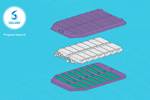Archer successfully completes multiple battery pack drop tests for Midnight aircraft
Proprietary battery pack design integrated into a composite battery enclosure passed extreme impact scenario simulations, setting the stage for upcoming for-credit testing with the FAA.
Archer Aviation Inc. (Santa Clara, Calif., U.S.) has successfully completed rigorous battery pack drop testing conducted at a National Institute for Aviation Research lab; the battery enclosures being used by Archer are made from fiber-reinforced composite materials. This testing — considered one of the most difficult to pass for electric vertical takeoff and landing (eVTOL) aircraft — continues advancement of the company’s proprietary electric propulsion system for its Midnight vehicle.
Archer’s engineering and certification teams led Midnight’s proprietary battery packs through three 50-foot drop tests simulating extreme impact scenarios. Tested at varying states of charge, 0%, 30% and 100%, the battery packs withstood the impact without any signs of failure and continued to function properly.
This test is renowned within the electric aviation industry as one of the most challenging barriers to certification, designed to ensure battery packs can safely endure significant impact. A pivotal factor in the success of these tests is Archer’s choice to use cylindrical cells within Archer’s battery pack design.
“Successfully passing the battery pack drop tests marks a pivotal moment that paves the way for future ‘for credit’ certification testing with the FAA,” says Alex Clarabut, Archer’s battery lead. “This accomplishment highlights our dedication to not just meeting, but exceeding safety standards. It is a critical step towards our goal of ensuring that Midnight will be among the safest aircraft in the skies.”
For more updates about Archer’s eVTOL developments click here.
Related Content
-
Paris Air Show 2023 highlights
The Paris Air Show, one of the largest aerospace trade shows in the world, returned for the first time since 2019 and proved that the global aviation industry industry is very much alive and kicking.
-
Alef Aeronautics earns FAA approval to launch flying car
FAA certifies testing of California startup Alef’s all-electric composite vehicle, which is drivable on public roads and has VTOL capabilities.
-
Hexagon Purus opens new U.S. facility to manufacture composite hydrogen tanks
CW attends the opening of Westminster, Maryland, site and shares the company’s history, vision and leading role in H2 storage systems.
















